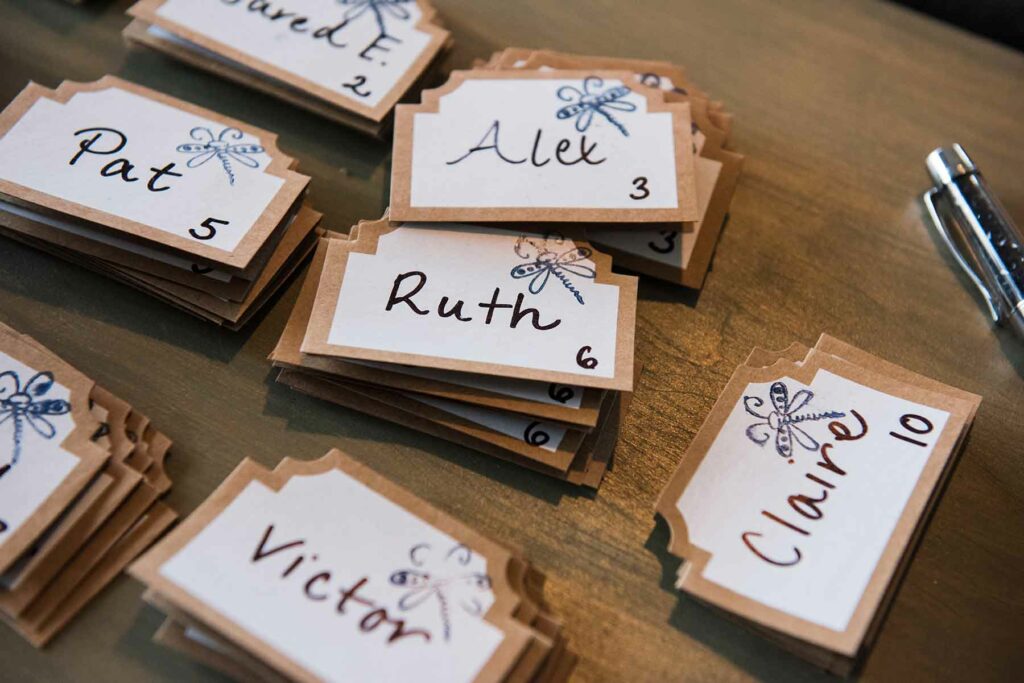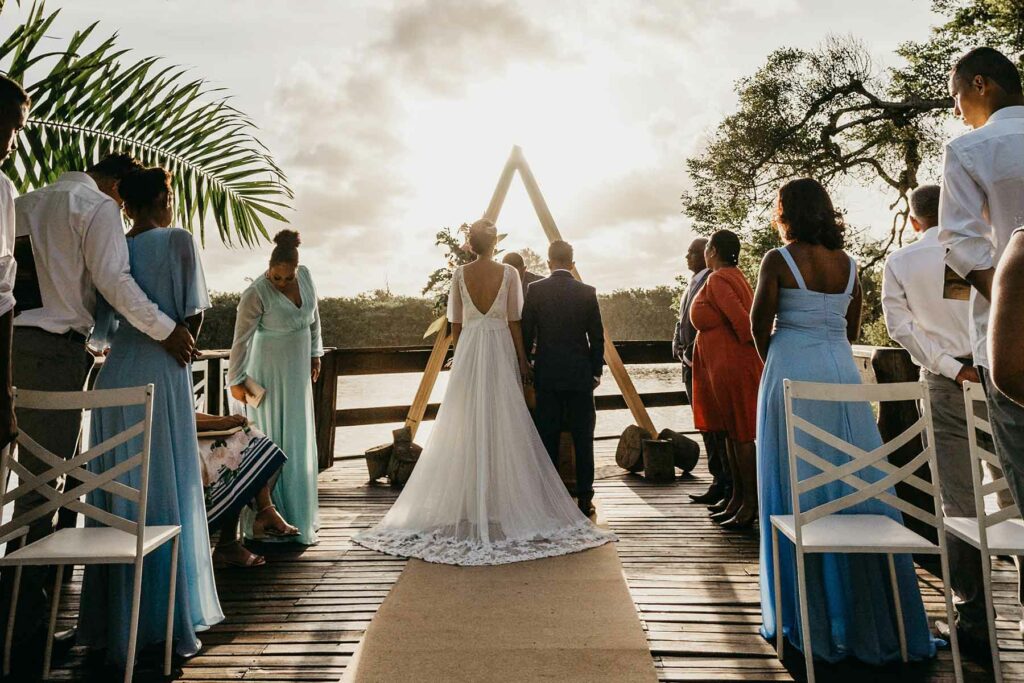Last Updated on October 16, 2023 by Joy Editors
Let’s face it — building your wedding guest list can be a stressful part of the wedding planning process. But without a doubt, it is one of the most crucial aspects to making your dream wedding come to life. The friends and family on your wedding guest list will shape the memories of your special day. Not sure where to start? We’ve got you covered with a step-by-step tactical guide for creating the perfect wedding guest list. Follow this checklist to get organized, be fair and stay on budget as you make your big day one to remember.
Step 1: Make Lists

The best place to start when creating a wedding guest list is … with a list. Or several, to be exact. Making lists will help you tackle this seemingly daunting task. You’ll gain clarity while calming those feelings of being overwhelmed.
To begin, start by writing down everyone you’d like to invite — no holds barred. You might consider making two lists between you and your partner. Divide and conquer, then see where they overlap. Getting your parents’ input may also be helpful if they’re in the picture. They may be able to jog your memory about family members you need to include but may have forgotten. Plus, it never hurts to have an extra set of eyes this early on in the process. And remember, this isn’t the final wedding guest list. You can always make cuts.
Next, categorize your lists as a strategy to get organized. Consider placing potential guests into different buckets. For example, group them into categories such as immediate family, closest friends, colleagues, casual friends and distant relatives. By moving names into different categories, it will give you a better visual of how many prospective guests you’re working with.
Step 2: Prioritize Your Guests
While prioritizing your loved ones can be difficult, it‘s an absolutely vital step toward finalizing your wedding guest list. This is the time for you and your partner to sit down and have a candid discussion. Your goal is to get a crystal clear picture of who you must have at your wedding — and who you’re still not entirely sure should be on the list.
Focus more on who you cannot imagine your wedding day without. These are the people who will be on the final list, no matter how many cuts need to be made. Think parents, siblings, best friends and your wedding party, for starters. Expand from there, as needed.
Organizing your non-negotiable loved ones this way will provide a starting point for shaping your final wedding guest list. It’s also important knowledge for making other decisions throughout the planning process. For example, you may be aiming for an intimate gathering but realize your list of non-negotiable guests is already 100 people long. In that case, you may need to shift gears toward a larger celebration. Creating this list of your nearest and dearest can give you a clearer picture of how big of a wedding venue you’ll need and, ultimately, how many open spots are available for others.
During this process, here’s a tip for what not to do: Don’t refer to them as your “A-List.” Trust us. While sometimes couples will extend last-minute invitations after the first round of regrets come in, creating any kind of secondary “B-List” could lead to unnecessary hurt feelings. At the end of the day, your goal is to create one list of people who will all receive invites to your wedding.
Step 3: Account for Extras, Like Plus-Ones and Kids

With any wedding, it’s likely you’ll need to account for extra people you didn’t anticipate in your initial guest count. Close family members and friends often come as package deals, for example, so you’ll need to remain a bit flexible on your seating chart. Whether that means your best friend’s significant other or your Aunt Susan’s kids, be prepared to add a few people to your final headcount.
Step 4: Keep Etiquette in Mind
After your group of must-include loved ones is set, you and your partner need to discuss the rest of the potential guests you wrote down in step one. Before you start cutting second and third cousins, however, it may help to get a refresher on wedding guest list best practices.
Most importantly, be respectful as you craft your invite list. Remembering to be fair and kind when inviting certain people will go a long way toward avoiding hurt feelings. For example, if you invite one of your first cousins, typically all first cousins should be invited on that side of the family. That doesn’t necessarily mean the other side of the family’s cousins need to be invited, or even that your partner’s cousins need to be included on the list. Also be mindful of any tension or family dynamics you need to navigate. Are any family members divorced or is anyone estranged? Make sure you’re being sensitive and look to mitigate this with a strategic seating chart.
The key to etiquette is to be consistent. That applies with everything from inviting kids to your plus-one policy. Speaking of kids, if you choose to have a child-free wedding, make this clear when extending the invitation. If etiquette is a concern, you can consider providing childcare options at your venue for those with young kids.
To avoid committing a wedding guest list faux pas, read our extended guide that features 10 dos and don’ts for etiquette best practices.
Step 5: Establish Your Own Rules

While you should be fair and respectful of who to include (while keeping proper etiquette in mind), it’s ultimately your special day. This is where establishing your own set of unique rules could prove to be very helpful. Create guidelines that work for your day and apply them across the board to your guests. You may not be able to make everyone happy, but as long as you’re fair there’s nothing to feel bad about.
Every couple is different, but here are some examples of rules that address common scenarios in the process of creating a wedding guest list.
- Plus-ones: You could choose to only allow plus-ones who you’ve met prior to your big day. Or perhaps your rule will account for plus-ones who are engaged or married to your friend or family member. Only allowing serious partners is an understandable ask if you’re trying to keep the wedding intimate.
- Kids: Even if you’re wanting an adults-only, kid-free wedding, there may still be some exceptions. Maybe children are only allowed if they’re participating in the wedding. Flower child? Sure, they’re welcome! Or perhaps you’re inviting young adults ages 16 and over. Just don’t be indiscriminate. You can’t make an exception for one cousin’s children because you feel like they won’t make a fuss during the ceremony but tell your other cousin their baby isn’t on the guest list.
- Co-workers: If it gets too difficult to decide which coworkers to invite without hurting feelings or leaving anyone out — or if there are simply too many to include — consider celebrating separately at a later time. Maybe you organize a fun party at a local bar or event space that’s dedicated to celebrating with coworkers.
Step 6: Budgeting for Your Wedding Guest List
Your wedding budget is one of the most important guiding elements to keep in mind while forming your guest list. Even if you don’t have an exact vision or venue, it’s time to begin assessing cost per person to execute all your wedding ideas. Just remember the rule of thumb: more guests mean a larger venue and a higher catering bill.
Consider if everyone on all your lists from step one will actually fit within the budget you and your partner discussed. If you have a dream wedding venue in mind, will it accommodate all these guests? Caterers typically charge per person, so multiply that cost by the number of guests. How close is this dollar amount to your actual budget?
Don’t forget to account for other small extras that add up based on the number of people on your wedding guest list. Even a dollar or two here or there per person for each line item can exponentially grow your budget. Wedding invitations, postage, chair rentals, cake cutting fees and favors are all areas where you’ll typically incur more costs with each additional guest.
While it may seem tempting to assume some out-of-town guests won’t attend and add a few more friends to the list, you should be prepared for everyone you invite to show up for the big day. Set your fiscal parameters and stick to them when building your guest list to avoid unnecessary stress that comes with overextending your budget.
Step 7: Consider Different Variables

Sometimes there are exceptions to best practices when it comes to making the ideal wedding guest list. If your big day falls under one of the following categories, you may want to consider these variables before finalizing your guest list.
- Destination weddings: If you’re hosting a destination wedding, the size of your guest list will invariably be smaller and more niche due to travel and accommodation logistics. You may choose to invite a very select group that can take the time and resources to travel to your unique destination.
- Reception-only guest list: Creating a reception-only guest list allows you to have a small wedding ceremony with key people while still celebrating with a larger number of people like friends and extended family at the wedding reception. It’s a win-win for anyone who has a lot of people they want to include but not the budget or space at the ceremony venue.
- Family rules: If a set of parents, in-laws or other family members are paying, they’ll most likely want to have more say in the guest list and the details of the wedding. You can show your respect by letting them weigh in on the elements they feel are important. However, keep in mind that it’s OK to speak up if the majority of your guest list is filled with people you don’t know. Looking back at your wedding photos and not recognizing any of the smiling faces doesn’t sound like a great way to remember this special day.
Step 8: Finalizing Your Wedding Guest List
Now for the hard part — narrowing down your list. Start with your budget and the total number of guests that figure can accommodate. After accounting for your non-negotiable guests and their plus-ones, you’ll likely have several spots left to fill. Now, go back to your lists from step one. Work your way through each category while applying the rules you and your partner established. Once you hit your max number of guests for your budget, you can refine from there.
Step 9: Managing Your Guest List

Congrats! Your wedding guest list has been made. But this to-do item on your wedding planning checklist isn’t over just yet. Setting up a system to manage this list is the best way to ensure the planning process runs smoothly.
You’ll need to gather all of your guests’ contact information and put it into a digital database like Joy’s Guest List Manager. Organizing all of their addresses, email addresses and phone numbers in one place is ideal for communication and efficiency. Joy’s Guest List Manager allows you to send save the dates, messages, and even track RSVPs all from one place — your wedding guest list. Wedding planning doesn’t get much easier than that!
Up Next:
Create the Perfect Wedding Website
Set up your wedding website in minutes with design options to make yours truly unique.


